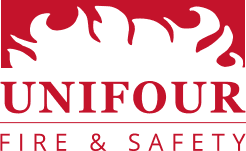
How To Decide How Many Fire Extinguishers Your Commercial Building Needs
 How many fire extinguishers do you need in your building? The answer isn’t as simple as it may seem. Chapter 6.2 of the NFPA 10 covers the rules required for the installation of portable fire extinguishers in commercial buildings. That’s where you can find all the nitty-gritty details about how many fire extinguishers your building needs.
How many fire extinguishers do you need in your building? The answer isn’t as simple as it may seem. Chapter 6.2 of the NFPA 10 covers the rules required for the installation of portable fire extinguishers in commercial buildings. That’s where you can find all the nitty-gritty details about how many fire extinguishers your building needs.
The regulations are particular and a little confusing, so the best way to ensure code compliance is to work with a fire protection company like Unifour Fire & Safety when selecting and installing fire extinguishers.
This guide can give you an idea of how many fire extinguishers you need based on your building’s size and fire hazard level. If you need help determining the number of fire extinguishers you need in your Southeast commercial building, contact Unifour Fire & Safety today.
Use Your Building’s Fire Hazard Level To Determine Extinguisher Size & Placement
The amount of fire risk that exists in a building is known as its fire hazard level. This determines how closely you must position fire extinguishers of a certain size. Fire hazard levels are usually categorized as light, ordinary, and extra. Commercial kitchens also have their own fire class and hazard levels.
Light Fire Hazard
What is a light fire hazard?
Schools, churches, offices, and hotels are considered light hazard buildings with minimal fire risk.
Size & Distance
- For Class A hazards, each extinguisher must be 2A or larger with a maximum travel distance of 75 feet between extinguishers.
- If there are Class B hazards, then 10B extinguishers should be positioned so the travel distance for an occupant to reach any extinguisher is 50 feet or less. 5B extinguishers should be placed so the travel distance to reach each extinguisher is 30 feet or less.
Ordinary Fire Hazard
What is an ordinary fire hazard?
Fabric stores, dry cleaners, post offices, hardware stores, and parking garages are all examples of buildings with ordinary fire risk. Flammable materials sit closely together, and ignition sources may or may not be present.
Size & Distance
- For Class A hazards, each extinguisher must be 2A or larger with a maximum travel distance of 75 feet between them.
- If there are Class B hazards, then 20B extinguishers should be positioned so the travel distance for an employee to reach any extinguisher is 50 feet or less, while 10B extinguishers should placed so the maximum distance between fire extinguishers is 30 feet or less.
Extra Fire Hazard
What is an extra fire hazard?
Furniture upholstering shops, assembly plants, die-casting facilities, and plastic processing factories have a high quantity of combustible contents, flammable liquids, and ignition sources, increasing their risk of fire.
Size & Distance
- For buildings with Class A hazards, each extinguisher must be 4A or larger with a maximum travel distance of 75 feet between them.
- For Class B hazards, 80B extinguishers should be positioned so the maximum distance between any fire extinguisher is 50 feet or less. 40B extinguishers should be placed so the distance to get to a fire extinguisher is 30 feet or less.
What’s Needed for Fire Hazards in Commercial Kitchens?
In addition to a commercial kitchen fire suppression system, kitchens require Class K extinguishers for cooking fires. If your building has a commercial kitchen, include enough Class K extinguishers so the travel distance for any employee to reach the extinguisher is 30 feet or less.
For fire extinguishers and fire suppression systems to help prevent commercial kitchen fires, call Unifour Fire & Safety today.
Fire Extinguisher Types & Sizes
Before you buy any fire extinguishers for your building, you must first understand your fire risks so you know what type and size to purchase. You’ll also want to know the appropriate fire extinguisher class to choose.
Fire extinguisher class designates which types of fires they’re designed to extinguish. There are a few common fire classes to know when shopping for fire extinguishers:
- Class A fires, which are the most common. They’re comprised of ordinary combustible products, including wood, paper, plastic, and fabric. Just about every commercial building is at risk for a Class A fire.
- Class B fires involve flammable liquids or gases, such as gasoline, oil, propane, and kerosene.
- Class C fires are fires that involve electrical wiring and thus pose the threat of electrocution.
The best way to combat all three of the most common types of fire is to buy multi-purpose ABC fire extinguishers. These have size ratings, which are indicated by a number in front of the letters A and B — for instance, 2A:10B:C. Higher numbers indicate greater fire extinguishing capacity.
Contact us today for help deciding what type of fire extinguishers will work best for your Southeast commercial building.
Fire Extinguisher Installation & Replacement in the Southeast
Does your commercial building in North Carolina, South Carolina, or Georgia need fire extinguishers? Unifour Fire & Safety can help. For decades, we’ve been helping prevent commercial fires throughout the Southeast.
Offering fire sprinklers, fire extinguishers, fire alarms, and more, we can help keep your building’s property and occupants safe. Contact us to learn more about how you can get your Southeast business up to code.
 Click to Apply
Click to Apply 


